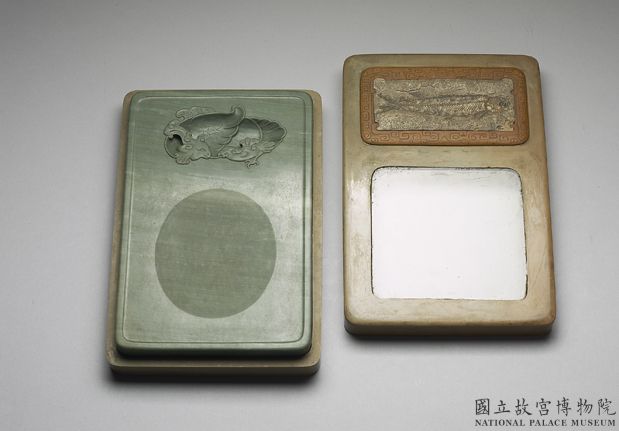Songhua inkstone with fish fossil inlay and paired phoenixes pattern, Qing dynasty, Kangxi reign (1662-1722)
- Image Number: K1F001372N000000000PAB
- Dynasty: Qing dynasty
- Category: Studio implements
- Function: Stationery
- Material: Minerals/Jade Jewelry/Songhua Stone
- Description:
The square green inkstone is smooth, with edges around the surface. A double phoenix shaped pool is formed under the body of a phoenix, with thin ridges around the pool; At the bottom left of the female phoenix head carving fish pond, look back at the young phoenix behind. Above the female phoenix head and beside the high relief fish pond at the neck of the young phoenix. A thick oval shape is left on the surface of the inkstone as the ink hall, leaving a slight mark, and the rest are polished smooth. The whole body of the inkstone has different green natural stripes. The back of the inkstone has wide ridges around it, and the lower part of the central recess is engraved with a running inscription: “It has a long life and is moist in quality, green in color and clear in sound, and the ink is beneficial to the brushwork, so it is also a treasure.” It is also engraved with square and round seals. The round seal is engraved with a line of four character seal characters: “Master of the Body”. The upper and lower seal characters are engraved with Qian and Kun divinatory symbols respectively, and the left and right are engraved with a dragon pattern respectively. The head of the dragon is up and down, and the left dragon body is not carved with lines, and it is slightly modified and widened; The square is engraved with two lines of four character seal character: “thousands of spare time”. Light green oval inkstone box, the box cover and the box body are buckled by the inkstone body. The box is made of yellow and green stone. The box is light green, nearly light yellow, with light blue spots on the back. The cover is divided into upper and lower layers. The upper layer is embossed with a box made of earth yellow stone. The lower side of the box is carved with two dragons facing each other. The intersection of dragon heads forms an animal face pattern. The dragon body extends to both sides. The upper side of the box is also carved with two dragons facing each other. The intersection of dragon heads also forms an animal face pattern; A fish fossil is embedded in the box. The lower layer is carved into a square with a glass inlaid for decoration, which can see through the inkstone surface. From the traces on the outer edge of the square of the inlaid glass, it is known that a square may be decorated, but the gold has been lost. There is a wide ridge around the back of the box. This piece was included in the “Western Qing Inkstone Manual”, named “Songhua Stone Double Phoenix Inkstone”, and was once used by the Emperor of the Qing Dynasty (probably the Emperor of the Qing Dynasty).

![图片[2]-Songhua inkstone with fish fossil inlay and paired phoenixes pattern, Qing dynasty, Kangxi reign (1662-1722)-China Archive](https://chinaarchive.net/Qing dynasty/Studio implements/K1F001372N000000000PAB-80103.jpg)
![图片[3]-Songhua inkstone with fish fossil inlay and paired phoenixes pattern, Qing dynasty, Kangxi reign (1662-1722)-China Archive](https://chinaarchive.net/Qing dynasty/Studio implements/K1F001372N000000000PAB-80104.jpg)
Pictures & Images [HD] download
© Copyright
The copyright of the article belongs to the author, please keep the original link for reprinting.
THE END





![[Qing Dynasty] British female painter—Elizabeth Keith, using woodblock prints to record China from the late Qing Dynasty to the early Republic of China—1915-China Archive](https://chinaarchive.net/wp-content/uploads/2022/11/image-191x300.png)